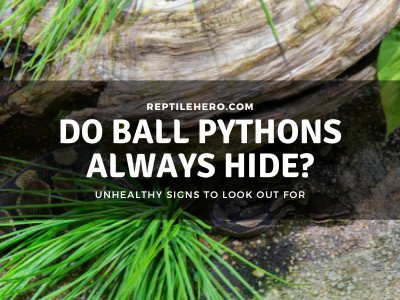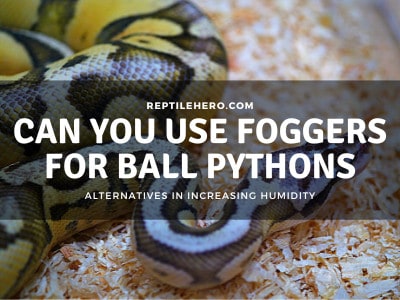Do Ball Pythons Burrow?
Are ball pythons capable of burrowing? As ball python keepers, we often notice unique behaviors from our snakes but is burrowing one of them?
Ball pythons can burrow under the substrate, hides, and water bowls. A ball python will burrow itself if it is about to shed, if it wants to explore, if it feels exposed, if it is too hot or cold, and if it has an illness.
In the wild, ball pythons are found in burrows made by other animals. So, in captivity, is burrowing a bad sign or is it normal? Can you stop your ball python from burrowing? Read until the end to know the answers to these questions and many more!
Is it Normal for Ball Pythons to Burrow?
It is normal for a ball python to burrow under hides, substrate, and water bowls. However, when it is accompanied by other sudden behavioral changes the ball python may be trying to shed and or experiencing husbandry-related issues.
For example, if you see your ball python burrowing under its hide, it usually means that they are just hiding to rest and relax during the day.
Other times, ball pythons burrow under substrate when they are trying to cool off or if they just want to hide.
So if you ever see your ball python burrowing, you should not worry immediately. t may just be a normal thing for your python.
But I still recommend checking tank conditions like temperature and humidity to ensure that everything is fine.
6 Reasons Why Your Ball Python is Burying Itself in Substrate
A ball python will bury itself under substrate due to: 1) shedding, 2) exploring, 3) lack of hides, 4) cooling off, 5) warming up, and 6) illnesses.
1. Shedding
Ball pythons that are about to shed will sometimes burrow themselves to moisten and rub off their old skin.
If your ball python is burying and staying still under humid substrates like coco fiber and cypress mulch, it may be soaking up moisture in preparation for shedding.
But if your snake displays erratic movement while burrowing, it may be rubbing itself using the substrate to loosen up its skin. This behavior is often seen with aspen substrate.
2. Exploring
Some ball pythons will burrow into the tank substrate out of a natural urge to explore. This means that pythons, at times, just normally bury themselves for no particular reason.
This behavior is observed in ball pythons kept in a terrarium that is equipped with a deeper substrate and other provisions that provide enrichment [1].
>>Want to learn more about enrichment? Check out our article about providing enrichment to ball pythons
You will know that your ball python is just burrowing for no reason if it is:
- Not shedding
- In a healthy condition
- Enclosure conditions (e.g., heat, humidity) are kept within their ideal range
3. Lack of Hides
Ball pythons that are not given hides can feel secure by burying themselves under the substrate. Hides must be appropriately sized and secured for a ball python to use it.
One keeper shared that her ball python has opted to burrow under the substrate because the hides she placed in the enclosure have been outgrown by the snake.
Another keeper stated that his ball python keeps burrowing into the substrate even though he has a properly-sized hide.
I saw the hide and, honestly, I think the python didn’t use it since it was too open. His ball python likely felt less secure and exposed inside that hide so it kept hiding in the substrate.
>>Learn more about finding the right hide for snakes in our article do ball pythons always hide?
4. Cooling Off
When feeling too hot, ball pythons will burrow themselves under the substrate to cool off. With overhead heating, specifically, the deeper part of the substrate is often cooler than the surface.
Ball pythons can overheat inside an enclosure with temperatures constantly at 95°F and above.
If you are currently using an overhead heat lamp and see your ball python often burrowing, the ambient temperature might be too high inside the enclosure.
To ensure proper temperatures at all times, connect all your heat lamps to a thermostat. Doing so can make heating devices safer for your ball python.
>>Want to find the best thermostat for you? Check out our article about choosing the right thermostat
5. Warming Up
In some cases, a ball python will burrow to warm up close to the heat mat below the tank, under the substrate.
Heat mats are often used as nighttime heaters since they don’t emit light. But they could present dangers for your pythons, especially when they’re feeling really cold at night.
Warning: Heat mats not regulated by a thermostat can cause belly burns to a ball python, especially if the snake has direct contact with the pad.
If you are using an under-tank heater, you cannot prevent a ball python from burrowing for heat. But I recommend only keeping the surface temperature of the plastic or glass tank floor with a heat mat around 87–89°F.
You can measure surface temperature with a temperature gun and the ambient temperature using a regular thermometer or the probe from your thermostat.
6. Illnesses
In rare cases, excessive burrowing can be a sign that the ball python is sick. Illnesses can cause immense stress in a python which urges it to hide more.
A ball python that keeps rubbing its head while it’s buried under the substrate might not be caused by shedding. Rather, it could be a symptom of either mite infestation or respiratory disease.
So if you see your ball python trying to burrow in a peculiar manner, check if it has black dots on its body which could be mites. Mites can be treated with a reptile mite spray or through predatory mites.
Also, check for wheezing and bubbles in the mouth for a respiratory infection.
However, ball pythons suspected of having any illness—especially respiratory diseases—must be brought immediately to a veterinarian for proper diagnosis and treatment.
Can You Stop Your Ball Python From Burrowing?
Ball pythons cannot be stopped from burrowing since it is a natural behavior in most cases. As long as the ball python and its living conditions are in great condition, burrowing is not a serious issue.
Burrowing can also serve as a form of enrichment for a ball python as it stimulates being underground—as they usually are in the wild.
I don’t recommend decreasing the amount of substrate in an enclosure just to prevent a ball python from burying itself under the substrate.
Why is Your Ball Python Not Burrowing?
Ball pythons that don’t bury themselves under substrate are also quite common and considered normal. Some individuals may not like to burrow. However, others are simply not burrowing because they are not given the opportunity.
For example, ball pythons that are given only a thin layer of substrate cannot burrow. The same can be said for snakes with a paper towel or newspaper substrate. A minimum of 3 inches deep substrate is recommended to allow a ball python to burrow.
Some breeders share that a few of their ball pythons can routinely be seen under their paper substrate even though they are provided with a spacious but secure hide. This can mean that they are seeking the opportunity to bury themselves under the surface.
It is always recommended to provide the best care to a ball python rather than the minimum required to survive. So the entire Reptile Hero team and I highly encourage providing our scaly babies with substrate that’s deep enough for burrowing!
Optimal care alongside enrichment will stimulate the parts of a ball python’s brain that are involved related to various things like climbing, burrowing, and exploration.
Where Do Ball Pythons Live in the Wild?
Ball pythons are found living in burrows made by termites, rodents, and other reptiles in the wild. Even though they often live underground, ball pythons cannot dig their own tunnels.
In the wild, ball pythons use burrows for shelter, mating, and egg-laying. Additionally, they are even known to raid rodent nests and inhabit them after eating the former occupants.

Fun Fact: The information regarding the habitat of ball pythons is gathered from not only field scientists but also from local snake hunters.
Hunters have been known to capture ball pythons including their eggs which will then be hatched in mass farms [2].
These are farms where wild-caught ball python eggs are placed to hatch, the babies are then sold or imported. This trade has been one of the most prominent sources of income for people in some parts of Africa since the emergence of ball pythons as pets.
Further Questions
Do ball pythons go underground?
Ball pythons are often observed living underground in Africa. They stay in burrows made by termites, rodents, and other reptiles. Ball pythons are also known to come out of their burrows during dusk, dawn, and nighttime to hunt, mate, and explore.
Are there snakes that can dig their own burrows?
Ball pythons cannot dig their own burrows but some snake species can create their own tunnels in the ground. Some common examples include hognose snakes and Kenyan sand boas that use their stubby nose to push substrate underground.
Summary of Do Ball Pythons Burrow
Ball pythons can and will burrow if given the opportunity to do so, like when their enclosure has a deep layer of loose substrate. They will burrow whenever they are about to shed, if they just want to explore, if they feel exposed, if they feel too hot or cold, and if they are sick.
Do not prevent a ball python from burrowing because it is considered a form of enrichment. However, a python may not burrow if it is only provided with a thin layer of substrate or a few sheets of paper-based substrates.
In the wild, ball pythons live in burrows made by rodents, termites, and other reptiles. They inhabit these areas for shelter, food, mating, and egg-laying.






